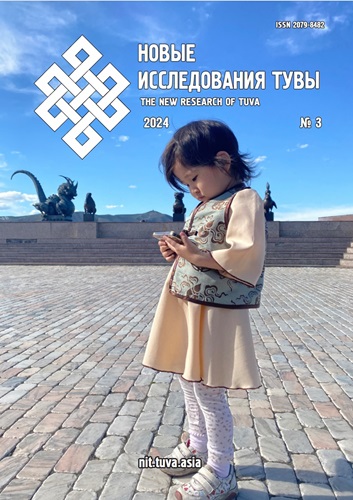Inter-regional educational migrations in Russia in 2017–2019: gender and spatial aspects
DOI:
https://doi.org/10.25178/nit.2024.3.13Keywords:
gender studies; regional demography; interregional migration; youth migration; educational migration; spatial development; Russia; region of Russia; Republic of TuvaAbstract
The article explores the gender and spatial aspects of interregional educational migration in Russia between 2017 and 2019, with a particular focus on young people aged 15–16 and 17–18. The study uncovers trends in the appeal of different regions for educational migrants and identifies gender differences in the choice of educational pathway and subsequent labor mobility.
The results of the study indicate that many Russian regions, including central Russia, the Rostov and Sverdlovsk regions, the Krasnoyarsk Krai and the Khabarovsk Krai, are attractive for educational migration. However, the Republic of Tatarstan and Primorsky Krai, despite significant investment in educational infrastructure, were found to be less so. Gender analysis showed that women's educational migration tended to focus on the largest agglomerations and western regions, while men's migration was often linked to military education and service.
The situation in the Republic of Tuva stands out as a unique case within the context of this study. Unlike in other regions, where female educational migration often has a low return, in Tuva, there is a significant return of young women aged 19-25.
The article proposes several recommendations to address gender imbalances, such as a more equal distribution of resource revenues and investments in economic diversification at the national and regional levels.
References
Abylkalikov, S. I. (2021) Features of the Demographic Development of Tuva: Contribution of Migration to the Demographic Balance. New Research of Tuva, no. 4, pp. 131–142. (In Russ.). DOI: https://doi.org/10.25178/nit.2021.4.10
Badmaeva, N. V. and Natsak, O. D. (2021) Modern labor migration from Kalmykia and Tuva: economic, socio-cultural and gender aspects. New Research of Tuva, no. 4, pp. 186–205 (In Russ.). DOI: https://doi.org/10.25178/nit.2021.4.14
Vorob'eva, O. D., Topilin, A. V., Grebeniuk, A. A. and Lebedeva, T. V. (2016) Analysis of migration processes according to population censuses in Russia. Economy of regions, no. 1, pp. 175–188. (In Russ.).
Gerasimov, A. A. (2022) Spatial patterns of age-specific sex ratios in Russian intraregional migration. Demograficheskoe obozrenie, no. 1, pp. 92–108. (In Russ.). DOI: https://doi.org/10.17323/demreview.v9i1.14575
Dozhdikov, A. V. (2023) Educational Migration in the Republic of Mordovia. Russian Journal of Regional Studies, no. 1 (122), pp. 182–198. (In Russ.). DOI: https://doi.org/10.15507/2413-1407.122.031.202301.182-198
Dozhdikov, A. V. and Kornilova, E. V. (2023) Educational Migration of Applicants Among Regions of the Russian Federation as a Data Source for Planning the Higher Education System Development. Vysshee obrazovanie v Rossii, no. 3, pp. 67–83. (In Russ.). DOI: https://doi.org/10.31992/0869-3617-2023-32-3-67-83
Dorzhu, Z. Yu. (2011) The Tuvan family: trends in its life activity. Omskii nauchnyi vestnik, no. 1 (95), pp. 35–38. (In Russ.).
Kasymova, S. R. (2012) Gender socialization of children in the context of labor migration from Tajikistan. Diaspory, no. 2, pp. 124–148. (In Russ.).
Kashnitskii, I. S., Mkrtchian, N. V. and Leshukov, O. V. (2016) Interregional Migration of Youths in Russia: A Comprehensive Analysis of Demographic Statistics. Educational Studies Moscow, no. 3, pp. 169–203. (In Russ.). DOI: https://doi.org/10.17323/1814-9545-2016-3-169-203
Mikriukov, N. Yu. (2023) Interregional and international migration as factors of gender disparities in the regions of Russia. Science. Culture. Society, vol. 29, no. 4, pp. 65–84. (In Russ.). DOI: https://doi.org/10.19181/nko.2023.29.4.6
Mkrtchian, N. V. (2021) Sex imbalances in long-term migration flows in Russia. Demographic Review, no. 3, pp. 6–19. (In Russ.). DOI: https://doi.org/10.17323/demreview.v8i3.13264
Natsak, O. D. (2021) Gender and demographic features of the labor market of the Republic of Tuva: trends and prospects. Population, no. 2, pp. 120–130. (In Russ.). DOI: https://doi.org/10.19181/population.2021.24.2.11
Rybakovskii, L. L., Martynenko, S. V. (2012) The gender aspects of global migration. Sotsiologicheskie issledovaniia, no. 4, pp. 35–41. (In Russ.).
Riazantsev, S. V., Sivopliasova, S. Iu., Rostovskaia, T. K. and Bushkova, L. A. (2018) Marriage emigration of women from russia: scale, reasons, features. Woman in Russian Society, no. 4 (89), pp. 85–99. (In Russ.). DOI: https://doi.org/10.21064/WinRS.2018.4.8
Riazantsev, S. V., Rostovskaia, T. K. and Peremyshlin, S. N. (2019) Gender aspects of labor migration in Russia: trends, implications, regulation. Woman in Russian Society, no. 4, pp. 53–65. (In Russ.). DOI: https://doi.org/10.21064/WinRS.2019.4.5
Semenova, N. B. (2017) Prevalence and risk factors of suicide among indigenous peoples: a review of foreign literature. Suitsidologiia, no. 1 (26), pp. 17–38. (In Russ.).
Sivopliasova, S. Iu. (2020) Gender-specific migration behavior of youth in Central Asia and Russia. In: International Demographic Forum: proceedings of the meeting / ed. by N. V. Iakovenko. Voronezh, Tsifrovaia poligrafiia. 982 p. Pp. 485–463. (In Russ.).
Khertek, Sh. V. (2016) Women's employment and unemployment in the Republic of Tuva. Sciences of Europe, no. 9–1 (9), pp. 62–65. (In Russ.).
Khramova, M. N. and Riazantsev, S. V. (2018) Factors of Emigration from Russia: Regional Features. Economy of Region, no. 4, pp. 1298–1311. (In Russ.). DOI: https://doi.org/10.17059/2018-4-19
Chernyshev, K. A., Mitiagina, E. V., Chernysheva, N. V. and Petrov, E. Iu. (2023) Incidence and directions of educational migration of Tuvan youth. New Research of Tuva, no. 2, pp. 70–83. (In Russ.). DOI: https://doi.org/10.25178/nit.2023.2.5
Published
How to Cite
For citation:
Bezverbny V. A., Mikryukov N. Y. and Sitkovsky A. M. Inter-regional educational migrations in Russia in 2017–2019: gender and spatial aspects. New Research of Tuva, 2024, no. 3, pp. 226-239 (In Russ.). DOI: https://doi.org/10.25178/nit.2024.3.13
Issue
Section

This work is licensed under a Creative Commons Attribution-NonCommercial 4.0 International License.

Author(s) license holder(s) grant rights for their work to the journal (grantee of a license) under the simple non-exclusive open license in accordance with Art. 1286.1 «Open license for a research work, work of literature or fine arts», Civil Code of the Russian Federation.
New Research of Tuva publishes articles under the Creative Commons Attribution-NonCommercial license (CC BY-NC).
Since it is an open license, author(s) reserve the right to upload the article to their institutional repository, submit it to another journal (if it allows republications), or republish it on their own website (in full, or in part).
However, several conditions apply here:
a) The republished version must always contain the name(s) and affiliation(s) of the author(s), the original title and the hyperlink to the original version on the New Research of Tuva website;
b) It must be in open access, free of charge, and no category of readers must be in any way whatsoever advantaged over general readership.
c) should the contribution be submitted elsewhere by its author(s) without substantial modification (30% or more of original text unchanged), the body of the article should contain a disclaimer that the original version was published in New Research of Tuva (with a link to the respective page)
The CC-BY-NC is a non-revocable license which applies worldwide and lasts for the duration of the work’s copyright.











